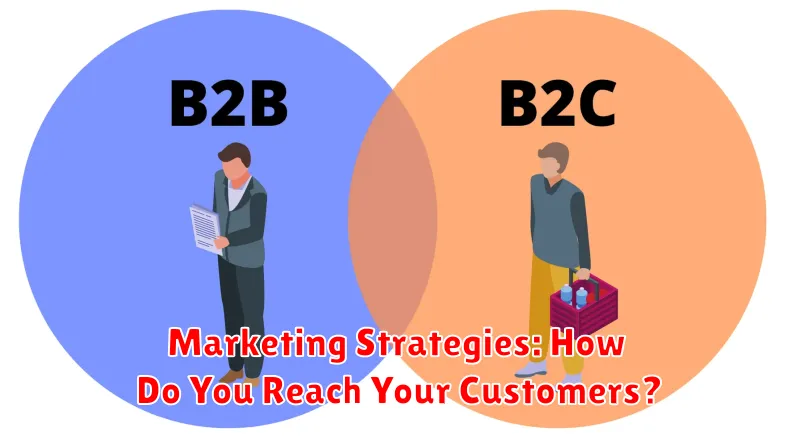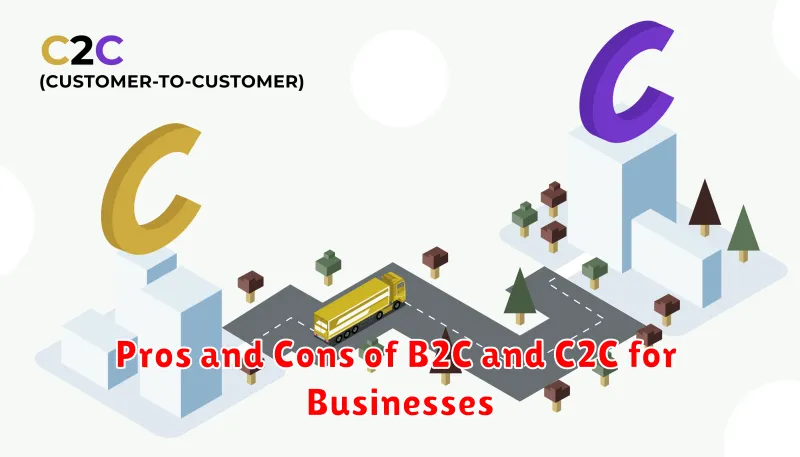Navigating the world of commerce requires a strong understanding of its various models. Two prominent models, Business-to-Consumer (B2C) and Consumer-to-Consumer (C2C), present distinct approaches to buying and selling. This article will delve into the key differences between B2C and C2C, exploring their respective advantages and disadvantages to help you determine the optimal model for your needs. Understanding the nuances of each, from marketing strategies to transaction processes, is crucial for success in today’s dynamic marketplace.
Whether you’re an aspiring entrepreneur looking to launch a new venture or an established business seeking to expand your reach, choosing the right model is paramount. This guide will provide a comprehensive comparison of B2C and C2C, covering key aspects such as regulations, scalability, payment processing, and customer relationship management. By examining these critical elements, you can make an informed decision that aligns with your business objectives and target audience. Discover the core distinctions between B2C and C2C and gain the insights necessary to choose the model that best positions you for success.
Defining B2C and C2C E-Commerce Models
Understanding the core distinctions between Business-to-Consumer (B2C) and Consumer-to-Consumer (C2C) e-commerce models is crucial for navigating the online marketplace. B2C represents transactions between a business and individual consumers. Think of purchasing clothing from an online retailer or subscribing to a streaming service. These businesses maintain inventories, manage marketing campaigns, and handle customer service directly.
C2C, conversely, involves transactions between two individual consumers. Platforms like online auction sites and classified advertisement websites facilitate these interactions. The platform provider typically handles payment processing and dispute resolution, while individual sellers manage their listings and shipping.
Target Audience: Who Are You Selling To?
Understanding your target audience is crucial for selecting the right e-commerce model. B2C and C2C models cater to distinct consumer groups, influencing every aspect of your business strategy.
In B2C, businesses directly target individual consumers for personal use. This audience varies greatly depending on the product or service offered, but the common thread is that purchases are intended for individual consumption rather than resale.
C2C e-commerce connects individual buyers and sellers. The target audience for a C2C platform is twofold: individuals looking to sell their used or new goods and individuals looking for deals or unique items often unavailable through traditional retail channels. This creates a dynamic marketplace where individuals play both the buyer and seller roles.
Identifying your ideal customer profile—their demographics, needs, and buying behavior—is essential for effective marketing and sales in either model. B2C sellers often focus on building brand loyalty and repeat customers, while C2C platforms prioritize facilitating seamless transactions and building trust among users.
Product and Service Offerings: What Are You Selling?
A key differentiator between B2C and C2C lies in the types of products and services typically offered. B2C businesses commonly sell new products, ranging from everyday consumer goods to specialized equipment, and often provide associated services like warranties and customer support. Think of electronics retailers, clothing stores, or streaming services.
C2C marketplaces, on the other hand, predominantly feature used or pre-owned items. Individuals sell directly to other individuals, offering a wide array of products, from clothing and furniture to collectibles and handmade crafts. Services are less common in C2C, though specialized skills like tutoring or freelance design work might be offered.
The scale of product offerings also differs. B2C businesses often maintain large inventories and can offer a consistent product selection. C2C sellers typically deal with individual items or small batches, resulting in a more dynamic and varied marketplace.
Marketing Strategies: How Do You Reach Your Customers?

Reaching your target audience requires distinct approaches in B2C and C2C models. B2C marketing often leverages professional techniques like search engine optimization (SEO), paid advertising, email marketing, and social media campaigns. These strategies aim to build brand awareness and drive traffic to a central platform (e.g., a company website or online store).
C2C marketing, in contrast, relies more heavily on organic reach within the platform itself. Sellers often utilize platform-specific features like in-app promotions, optimized product listings, and engaging with potential buyers directly through messaging or community forums. Building a strong reputation through positive reviews and ratings is crucial in the C2C space.
Understanding these differences is crucial for choosing effective marketing tactics. A B2C business might invest in creating high-quality content and running targeted ad campaigns. A C2C seller, on the other hand, might focus on crafting compelling product descriptions and actively participating in relevant online communities.
Payment Processing and Logistics: How Do Transactions Work?
Payment processing and logistics differ significantly between B2C and C2C models. In B2C, the business typically integrates various payment gateways offering credit/debit card processing, digital wallets, and sometimes even financing options. Logistics are often streamlined with established shipping partners and dedicated fulfillment centers, offering standardized shipping options and tracking capabilities. The business bears the responsibility for managing returns and refunds.
C2C platforms, however, provide a facilitated marketplace. Payment processing is handled through the platform itself, often offering escrow services to protect both buyers and sellers. Shipping logistics are generally the responsibility of the individual seller, leading to a wider range of shipping methods and costs. Return and refund policies are less standardized and depend heavily on individual seller agreements or platform dispute resolution systems.
Regulations and Legal Considerations for Each Model
B2C transactions are subject to more stringent regulations than C2C. Businesses selling directly to consumers must comply with various consumer protection laws, including those related to product safety, advertising, and data privacy. These regulations often involve specific labeling requirements, warranty obligations, and refund policies.
C2C transactions, while generally less regulated, still fall under certain legal frameworks. Consumer protection laws still apply, although the enforcement and responsibility are often shared between the platform facilitating the transaction and the individuals involved. Issues such as fraud, misrepresentation, and dispute resolution can be more complex in C2C settings due to the lack of a formal business entity involved.
Tax regulations also differ between the two models. B2C businesses are typically required to collect and remit sales tax, while tax obligations for C2C transactions can vary depending on the platform and local laws. Sellers on C2C platforms may be responsible for reporting and paying taxes on their sales, though enforcement can be challenging.
Pros and Cons of B2C and C2C for Businesses

B2C (Business-to-Consumer)
Pros: B2C businesses often enjoy higher profit margins due to direct control over pricing and branding. They can build stronger brand loyalty through direct customer relationships and targeted marketing. Streamlined operations and inventory management are also common advantages.
Cons: Significant investment is often required in marketing, customer service, and logistics. Competition can be fierce, requiring ongoing innovation and adaptation to market trends. Managing customer expectations and handling returns can be resource-intensive.
C2C (Consumer-to-Consumer)
Pros: C2C platforms benefit from lower overhead costs as they don’t hold inventory or manage shipping directly. They generate revenue through transaction fees and advertising. The broader market reach allows for a vast product selection and attracts a large user base.
Cons: C2C businesses have less control over product quality and pricing. Dispute resolution between buyers and sellers can be a challenge. Building trust and ensuring platform security are crucial for success but can be complex.
Choosing the Right E-Commerce Model for Your Needs
Selecting between B2C and C2C depends entirely on your business objectives and the type of product or service you offer. Consider the following factors to determine the best fit:
Control vs. Flexibility
If you prioritize control over branding, pricing, and customer experience, the B2C model is generally preferred. If you value flexibility and minimal overhead, and your product or service lends itself well to peer-to-peer transactions, the C2C model might be a better option.
Scalability and Growth
B2C often allows for greater scalability due to direct management of inventory and operations. C2C can experience rapid growth organically but scaling can present unique challenges due to reliance on individual sellers.
Resource Commitment
B2C typically requires a greater upfront investment in infrastructure, technology, and marketing. C2C platforms often involve lower initial costs, focusing on providing the marketplace infrastructure.
Target Audience
Understanding your target audience is crucial. Consider their purchasing habits, preferred platforms, and expectations regarding customer service. This will inform your choice between the direct interaction of B2C and the community-driven approach of C2C.

